
Oswald Did NOT Purchase a Rifle from Kleins
by John Armstrong
For nearly 50 years the public has been confused and purposely misled by a systematic and continuous barrage of disinformation relating to the assassination of President Kennedy. This began with the illusion that Oswald was the lone assassin. This illusion was created by the Warren Commission, based upon altered and fabricated FBI reports and documents, and continued with the House Select Committee on Assassinations, and was continuously promoted with an endless stream of Oswald-did-it books and made-for-TV documentaries. Over the years numerous books were written about the life of Lee Harvey Oswald by his mother, his widow, and his brother--people who allegedly knew Oswald better than anyone. But these books in particular are filled with inaccuracies and were designed and promoted to fool and confuse the public about the life and background of Lee Harvey Oswald.
The majority of Americans believe the assassination of President Kennedy was the result of a conspiracy and few believe that Oswald was the lone assassin. Many of these people have been hoping for a "smoking gun" to emerge that would solve the JFK mystery once and for all. But even though a single "smoking gun" is an illusion, there are many, many "smoking guns" and they have been there for years--right before our eyes. These "smoking guns" are often overlooked and misunderstood because they seem insignificant and inconsequential. They consist of numerous unexplained events, confusing and misleading pieces of information, fabricated evidence, incomplete testimony, and outright lies that have never been thoroughly investigated or properly explained. By studying the small details and contradictions, we slowly begin to understand their meaning and their purpose. By linking these details together, piece by piece, what emerges is the larger than life "smoking gun" that has eluded us for so long. As my good friend and long-time JFK researcher Malcolm Blunt has said to me again and again, "the devil is in the details." Study these details, the minute details, again and again, and you most certainly will learn and understand the devils who were behind the assassination of President Kennedy.
Two of the most misunderstood "smoking guns" in the assassination are, ironically, the rifle and pistol allegedly ordered and purchased through the mail by Oswald. If Oswald did not purchase the weapons recovered by the Dallas Police, then how could he have killed JFK and Officer Tippit? These two "smoking guns" will not show us who was behind the assassination, but they will clearly show that the FBI deliberately manipulated crucial pieces of evidence in order to frame Oswald. And they will show how the Warren Commission used FBI reports, testimony from FBI officials, and documentation acquired by the FBI in a blatant and deliberate attempt to "prove" that Oswald purchased and used an old Italian-made rifle to murder President Kennedy and the pistol to murder Dallas Police Officer Tippit. Both the FBI and the Warren Commission intentionally ignored anything and everything that would have exonorated Oswald. Now, let's look at some of the details carefully, piece together what really happened with the rifle and pistol, and find out how and why we were misled.
In New Orleans, on August 16, 1963, Lee HARVEY Oswald handed out Fair Play for Cuba pamphlets, which gave a false impression that Oswald supported Fidel Castro and Cuba. Helping Oswald distribute the pamphlets was Charles Hall Steele, an active FBI informant identified as "NO-T-14". Their leaf-letting activities were filmed by WDSU cameraman Orvie Aucoin, also an active FBI informant, in front of Clay Shaw's International Trade Mart and shown on television shortly after the assassination of JFK. WDSU also took films of Oswald's court appearance and of Oswald's interview at WDSU. Two weeks later, on Labor Day weekend, a more ominous attempt to link Oswald to Castro and Cuba occurred.
 In
the 1950s, prior to the
Cuban revolution, Robert
McKeown supplied arms to Fidel Castro and became one of Castro's best
friends. After the
revolution Castro flew to Houston and met personally with McKeown at
the airport. Castro
tried to convince McKeown to return to Cuba with him and
offered McKeown business concessions or a high position in the Cuban
government. McKeown politely refused and Castro returned to Cuba,
but the two men remained close friends. Several months later friends
of McKeown's brother were arrested by the Cuban militia when fishing
within Cuban waters and thrown in jail. When McKeown was told that
his brothers' friends
were in jail in Cuba, he telephoned Castro and the men were released
immediately. The multi-year
close relationship between Fidel Castro
and Robert McKeown did not go unnoticed.
In
the 1950s, prior to the
Cuban revolution, Robert
McKeown supplied arms to Fidel Castro and became one of Castro's best
friends. After the
revolution Castro flew to Houston and met personally with McKeown at
the airport. Castro
tried to convince McKeown to return to Cuba with him and
offered McKeown business concessions or a high position in the Cuban
government. McKeown politely refused and Castro returned to Cuba,
but the two men remained close friends. Several months later friends
of McKeown's brother were arrested by the Cuban militia when fishing
within Cuban waters and thrown in jail. When McKeown was told that
his brothers' friends
were in jail in Cuba, he telephoned Castro and the men were released
immediately. The multi-year
close relationship between Fidel Castro
and Robert McKeown did not go unnoticed.
After the Cuban revolution, Jack Rubenstein contacted McKeown and said he knew that McKeown had influence with Castro. He wanted McKeown's help in getting three individuals out of Cuba. Rubenstein offered McKeown $5,000 for each person who was released, but never came up with the money. Three weeks later a man approached McKeown and introduced himself as Jack Ruby. He told McKeown that he had an option to purchase a large number of jeeps and wanted to sell them to Castro. Ruby wanted a letter of introduction from McKeown, offered to pay $25,000, but never came up with the money.
On Saturday morning, between 9:00 am and 10:00 am on Labor Day weekend, a car arrived at McKeown's home in Baycliff, TX. McKeown, his wife, and friend Sam Neil were in the house when the car arrived and two men walked to the house and knocked on the door. When McKeown opened the door one of the men said, “You are McKeown, are you not? I understand that you can supply any amount of arms.” McKeown asked for the man's name and he introduced himself as "Lee Oswald." Oswald said he wanted to purchase four .300 Savage rifles with scopes and offered to pay Mckeown $10,000. McKeown was on probation for running guns to Castro, and was skeptical of these visitors. He wondered why Oswald would offer him $2500 for a rifle that he could buy at Sears and Roebuck for $75. McKeown then told Oswald that he was on probation and didn't want to get involved selling any more guns. Oswald got in his car and started to drive away, but stopped and once again walked to McKeowns house. He pleaded with McKeown to sell him rifles, but McKeown refused and went back into his house. Following the assassination Sam Neil telephoned McKeown and said, "Mac, are you watching TV? ….That's the bastard who was at your house that got killed, that Ruby killed.” McKeown was not interviewed by the WC, but was interviewed for hours by the HSCA. They asked why Oswald would offer him so much money for the rifles. McKeown replied, “That is what puzzled me, why would he come to me to buy rifles.”
McKeown may have been puzzled, but it made perfect sense to those who were setting up HARVEY Oswald as the “patsy” and attempting to blame Castro for the assassination.
If McKeown had accepted Lee Oswald's offer of $2500 per rifle, then one of those rifles would have been found on the 6th floor of the TSBD by Dallas Police. And that rifle would have been traced back to Castro's close friend, Robert McKeown. The attempt to link (HARVEY) Oswald to Castro through FPCC brochures, Mexico City, Robert McKeown, and radio interviews in New Orleans with CIA asset Edward Scannell Butler is undeniable.
Lee Oswald's attempt to purchase a rifle from Castro's close friend, Robert McKeown, in early September, 1963 strongly suggests that the choice of a rifle to be placed on the 6th floor of the TSBD had not yet been made. This is reason to believe that the Mannlicher Carcano rifle found on the 6th floor was not chosen as the “murder weapon” until after Labor Day weekend, 1963. Despite what is indicated in the Warren Report, neither Oswald nor anyone else ordered a Mannlicher Carcano rifle from Klein's Sporting Goods in March, 1963. Oswald's purchase of a mail order rifle was a complete hoax, with documentation fabricated by the FBI and witness testimony carefully guided by WC attorneys.
FABRICATING A HOAX
MAIL ORDER RIFLE. According to the Warren Commission Lee HARVEY Oswald left his job at Jaggers-Chiles-Stovall during the morning of March 12, walked 11 blocks to the downtown post office, purchased a postal money order, and then mailed his order for the rifle to Klein's Sporting Goods in Chicago before returning to work. But the letter was postmarked 10:30 am, and company time records show that Oswald never left his job. He worked continuously from 8:00 am through 12:15 pm on 9 different printing jobs.
The Warren Commission never pointed out that the envelope, time stamped 10:30 am, was not mailed from the downtown post office where the money order was purchased. It was stamped and mailed in "zone 12," which was several miles west of the downtown post office and across the Trinity River. In order for this letter to have reached Chicago the following day, it would have to have been picked up by a mail carrier sometime after 10:30 am, delivered to the Industrial Station post office in zone 7, and then sorted and bagged into an airmail pouch. And the airmail pouch would have to have been delivered by another mail carrier to Love field and then placed aboard an aircraft prior to it's 12 o'clock noon departure.
If we are to believe the Warren Commission, then we believe that Oswald skipped work for an undetermined period of time on the morning of March 12, walked 11 blocks to the post office, purchased a postal money order, traveled several miles across the Trinity River in order to mail the letter, and then returned to his job unnoticed. And then, if we believe the Warren Commission, this letter was picked up by a mail carrier sometime after 10:30 am in zone 12, delivered to the post office in zone 7, sorted and placed into an airmail pouch, transported to the Love Field Airport, and loaded aboard the last flight to Chicago before the plane departed at noon. This money order was allegedly received by Klein's Sporting Goods in Chicago the following morning, was included with over a thousand other mail orders from around the country, and then deposited into Klein's bank account. If this sounds a little far-fetched, believe me, it gets better.
All US Postal Money orders have unique serial numbers. In the fall of 1962, Oswald purchased numerous money orders from the same downtown post office and mailed them to Washington, DC in order to repay a loan from the government for his travel expenses incurred when he returned to the USA from Russia. These money orders were purchased in numerical sequence beginning in November, 1962. These serial numbers show that some 1200 money orders per week were purchased at the downtown post office in Dallas. At this rate we see that Oswald's alleged purchase of a money order on March 12, 1963 should have been numbered 2,202,011,935. But the serial number of the money order published in the Warren Volumes was more than 118,000 numbers higher. At the rate of 1200 money order per week, this money order should have been purchased in late 1964 or early 1965. In other words, this money order could easily have been pulled from a stack of fresh, unsold money orders by a postal official in Dallas, sometime after the assassination, and then given to the FBI. A close look at the details surrounding the "finding" of the money order the day after the assassination strongly suggests that this is what happened.
MANNLICHER
CARCANO RIFLE-C2766.
Crescent Firearms was a major importer of firearms from Italy and was
required by law to keep and maintain a list of serial numbers for all
firearms they imported and sold to retailers, such as Klein's Sporting
Goods in Chicago. The Dallas Police found an Italian Mannlicher Carcano
rifle, serial number C2766, on the 6th floor of the Texas School Book
Depository building following the assassination of President Kennedy.
That evening (11/22/63) the owner of Crescent Firearms, Louis Feldsott,
was contacted by the FBI in New York and asked if his company had
records concerning the importation and sale of this rifle. Feldsott
searched his records and found that a Mannlicher Carcano rifle, serial
number C2766, had been sold to Klein's Sporting Goods in Chicago on
June 18, 1962. Feldsott turned his original records over to the FBI,
and those records disappeared. He allegedly told an FBI agent
the rifle was 36", but without original records the model number and
length of this rifle sold on June 18, 1962 are unknown. There was no
description of this rifle (C2766) given by Feldsott in his
affidavit, and the FBI withheld all information relating to this
rifle.
NOTE: It is important to remember that Feldsott told the FBI that his records showed C2766 was sold to Klein's on June 18, 1962. The Warren Commission, from photographic records provided by the FBI (photographs--not original records), concluded that Crescent Firearms sold C2766 to Klein's in February, 1963. The WC obtained a signed affidavit from Feldsott wherein he stated that "C2766" was sold to Klein's on June 18, 1962. But they never obtained an affidavit or testimony from Feldsott that indicated he sold another rifle, with serial number C2766, to Klein's in February, 1963 or any time. Debate continues as to whether there was more than one Mannlicher Carcano rifle with serial number C2766. But the answer to that question may be that a second Mannlicher Carcano rifle, with serial number C2766, has never been found.
The FBI agents who visited Feldsott likely reported their
findings to the SAC New York immediately. The SAC New York likely
provided the same information to FBI headquarters in Washington, DC,
who in turn probably instructed the FBI's office in Chicago to
send agents to Klein's to search records for the sale of C2766 from
Crescent to Klein's on June 18, 1962. Prior to visiting Klein's, this
was the only available information the FBI had relating to the sale of
C2766.
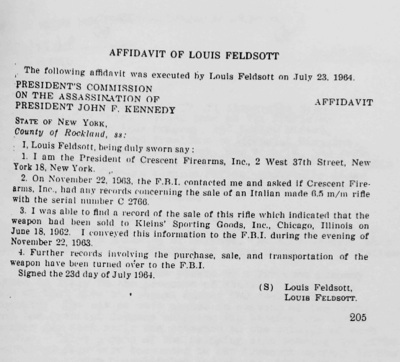
KLEIN'S
MICROFILM. The
FBI's Chicago office sent 3 agents to Klein's late in the evening of
November 22. These agents arrived at Klein's at 10:00 PM and were
met by Klein's Vice-President William Waldman. These agents were likely
told to search Klein's records (microfilm) and determine both the name
and address of the person who purchased C2766 from Klein's in 1962, and
determine if another rifle bearing serial number C2766 had been sold.
Seven hours later, at 5:00 AM in the morning, the FBI agents advised
Waldman that they had found records relating to C2766 and asked if they
could take the microfilm. Waldman agreed and the FBI agents left with
the microfilm. The FBI never produced a single document that shows the
date C2766 was delivered to Klein's (sold by Crescent on June 18, 1962)
nor the identity and address of the person who purchased that rifle
from Klein's. All original records from Crescent Arms (Louis Feldsott's
company) and the Klein's microfilm disappeared while in FBI custody.
Only "photographs" of documents were given to the WC, and are now at
the National Archives.
NOTE: The FBI agents also found records that Klein's sold a rifle similar to that found on the 6th floor of the TSBD for $21.95 with a postal money order that was issued on March 20, 1963 (CD 296). The FBI provided no information as to the serial number of this rifle, the model number of the rifle, the name of the purchaser of this rifle, or the location of the post office from which the $21.95 money order was purchased. This may have been the postal money order that J. Edgar Hoover was referring to when he advised President Johnson at 9:00 AM on the morning of 11/23/63 that the bureau had recovered the money order used to purchase the rifle. Researchers will recall that the $21.45 postal money order (pictured below) was allegedly found in Arlington, VA during the evening of 11/23/63.
On the morning of 11/23/63 the FBI, from original Crescent Arms
records and the original Klein's microfilm likely knew
the name and address of the individual who purchased the Manlicher
Carcano, serial number C2766, from Kleins--the same rifle that Crescent
sold to Klein's on June 18, 1962. They also likely knew the
name and address of the individual who purchased a rifle from Kleins
with a $21.95 postal money order that was issued on March 20, 1963. But
neither of these rifles could, allegedly, be linked to the
Manlicher Carcano rifle (with scope), serial number C2766, that was now
at FBI headquarters.
A $12.78 MAIL ORDER RIFLE. The FBI soon announced that LHO had
purchased a mail order rifle from Klein's Sporting Goods for $12.78
that was used to assassinate President Kennedy. But how did the FBI
determine the price of the rifle was $12.78? Did the Klein's microfilm
show that the rifle (C2766) Crescent sold to them on June 18, 1962, was
the same rifle that was re-sold for $12.78 to an individual the FBI
refused to identify? The FBI eventually realized that a $12.78 mail
order rifle was a problem. The price of a MC rifle sold by Klein's
without a scope was $12.78, but the rifle found by the Dallas
Police on the 6th floor of the TSBD had a 4 x 18 power scope and
was sold by Klein's for $19.95 ($21.45 including postage). There was
also a timing problem. Crescent's records showed they sold only one
Mannlicher-Carcano rifle with serial number "C2766" to Klein's, and
that was on June 18, 1962. But Oswald allegedly purchased a Mannlicher
Carcano rifle (C2766) from Klein's nine months later--in March, 1963.
The FBI had to determine, or come up with a story, as to
Oswald/Hidell's purchase of C2766 in March, 1963. They also had to
explain how and where a scope was installed on a $12.78 mail order
rifle. While the $12.78 mail order rifle was reported nationwide by
news and television
reporters for the next week (11/23/63 thru 11/29/63) the FBI ignored
Feldsott and his records, and all attention was focused on the 40"
Mannlicher Carcano rifle (C2766) with a 4 power Japanese scope at FBI
headquarters.
NOTE: If the Klein's microfilm records, bank records, and a $21.45 postal money order were in FBI custody on 11/23/63, as reported by the Warren Commission, there would be no confusion. The FBI would have announced that the rifle in their possession was purchased via mail-order by Oswald/Hidell from Klein's Sporting Goods for $21.45. However, it would appear that the only original records the FBI ever had for C2766, at any time, was the sale of this rifle from Crescent to Klein's on June 18, 1962, and a subsequent sale to an individual whose identity the FBI withheld.
6.5
mm ammunition.
The FBI, after checking gun and sports shops in and around Dallas/Ft.
Worth, was unable to determine where or when Oswald had purchased 6.5
mm ammunition for the Mannlicher-Carcano rifle. The FBI determined the
ammunition had been manufactured by the Western Cartridge Corporation
of East Alton, Illinois. The company manufactured four million rounds
of this ammunition for the US Marine Corps in 1954, yet this ammunition
did not fit and could not be used in any USMC weapon. An FBI memo,
dated 12/2/63, stated "this gives rise to the obvious speculation that
it is a contract for ammunition placed by CIA with Western under a USMC
cover for concealment purposes."
IRVING
SPORTS SHOP. The day after the assassination (Saturday
afternoon-11/23/63) gunsmith Dial Ryder found an undated repair ticket
on his workbench at the Irving Sports Shop. The repair ticket had
notations "drill and tap $4.50; bore sight $1.50; total $6.00" (work
required to mount a scope). The name "Oswald" appeared on the ticket,
but the ticket was undated and had neither a complete name nor an
address nor a phone number. Ryder told the WC that he did not mention
the repair ticket to anyone that weekend.
At 10:30 AM on Monday, November 25, FBI agent Emory Horton contacted
and interviewed Ryder at his home in Irving, TX. It has never been
determined how the FBI knew to send agent Horton to visit Ryder.
Horton showed Ryder photographs of C2766 and photographs of Oswald.
Horton asked Ryder if he knew Oswald or remembered working on this
rifle. Ryder told agent Horton that he did not remember Oswald and he
definitely had never worked on an Italian rifle. Ryder told the agent
that he had a repair ticket with the name "Oswald" and notations for
drilling, tapping, and boresighting. To the best of his memory, Ryder
said this work had been performed between November 1 and November 15 at
the Irving Sports Shop, but not on an Italian rifle.
Edith Whitworth was the owner of the Furniture Mart, located a block
and a half from the Irving Sports Shop. Mrs. Whitworth and her friend
Gertrude Hunter, told the WC that (LEE) Oswald, wife, and two children
drove to her shop in a blue and white two-tone 1957 Ford on either
November 4th (Monday), 5th (Tuesday), or 6th (Wednesday)--the same
time that HARVEY Oswald was working at the TSBD. (LEE) Oswald
brought in a long, slim, wrapped package and asked if she had a
particular part for a gun. Mrs. Whitworth told Oswald they no longer
dealt with guns and refererred him to the Irving Sports Shop, owned by
her friend Woodrow (Woody) Greener.
NOTE: In July, 1964 the WC brought Mrs. Whitworth, Mrs. Hunter, and Marina Oswald together. Marina said she did not know either Mrs. Whitworth or Mrs. Hunter and had never been to the Furniture Mart. But both Mrs. Whitworth and Mrs. Hunter insisted she was there with her husband and two children. The WC never understood nor was able to resolve this discrepancy. It should be remembered that (LEE) Oswald, wife, and children were also seen together as a "family" in Oak Cliff, Baton Rouge, New Orleans, and Alice, TX when impersonating HARVEY Oswald.
Ryder's boss and owner of the Irving Sports Shop was Woodrow (Woody)
Greener. Following the assassination Mr. Greener (as well as the FBI)
telephoned every listing for "Oswald" in the Dallas and Irving
telephone directories in an attempt to locate the person named on the
repair ticket. They were unsuccessful. It is obvious that LEE Oswald
was impersonating HARVEY Oswald when he visited the Furniture Mart and
then visited the Irving Sports Shop. LEE Oswald left a rifle at the
shop with instructions to mount a scope and picked up the rifle a few
days later.
$21.45 MONEY ORDER.
When postal money orders were produced/manufactured at the printing
office (circa 1963) twelve small, rectangular holes were punched on the
card stock used to make postal money orders. These punched holes,
identified by Hollerith machine code as numeric numbers, matched the
serial
number printed on the front side of each postal money order. These
holes made it possible for large volumes of postal money orders to be
electronically sorted and arranged in a systematic way after being
returned to a US Postal repository by the banking system. The
rectangular punched holes on CE788 identify the serial number of this
money order as 2,202,130,462, which is printed on the front side of
this mone order. This was the postal money order allegedly
used to pay for the Mannlicher Carcano rifle. FBI
records allegedly show that on
November 23, at 7:55 pm (CST), Secret Service Agent Grimes was told
that a $21.45 money order had been located in Washington, DC by Robert
Jackson, an employee of the National Archives. But why would an
employee of the National Archives have access to archived U.S. Postal
records late on Friday evening? And how is it possible that a
never-deposited, never-cashed US postal money order could be deposited
at the FNB of Chicago, routed thru the Federal Reserve Bank, and then
sent to a postal facility for storage (there are no bank endorsement
stamps from either the FNB of Chicago, the Federal Reserve Bank, or the
US Postal facility in Kansas City)? And why was that unpaid money
order
allegedly found at the US postal facility in Arlington, VA, and not at
the US postal facility in Kansas City where all other unpaid money
orders that
Oswald purchased from the Dallas post office were stored? The
answer is that this $21.45 money order was never cashed, never
deposited, and never routed thru the Federal Reserve banking system.
This unpaid money order was most likely taken from a stack of
new
money orders on 11/23/63 at the Dallas post office by US Postal
Inspector Harry Holmes, a long-time FBI informant identified by the
bureau as "Dallas, T-2". Holmes was likely the person who date stamped
the money order "March 12, 1962" and it was then sent directly to FBI
headquarters. The serial numbers on this money order indicate that it
was "pulled" from a stack of new money orders at the Dallas post office
in late 1963.
The simple conclusion is that the FBI knowingly obtained this unused,
unpaid money order from Postal Inspector Harry Holmes and then
provided photographs of this unpaid money order to the Warren
Commission. And
the Commission knew, in the person of attorney David Belin, that they
were offering this unpaid, never deposited money order as proof that
Oswald purchased a mail order rifle from Klein's. This unpaid money
order is
the key to understanding that the FBI and Warren Commission knowingly
created the hoax that Oswald purchased a mail order rifle from Klein's
that he used to assassinate President Kennedy. This unpaid money order
is one
of the most important "smoking guns" found in the Warren Volumes. It
proves that Oswald did not purchase a mail order rifle, and it shows
that both the FBI and Warren Commission knew that this unpaid
money order had never
been cashed or deposited.
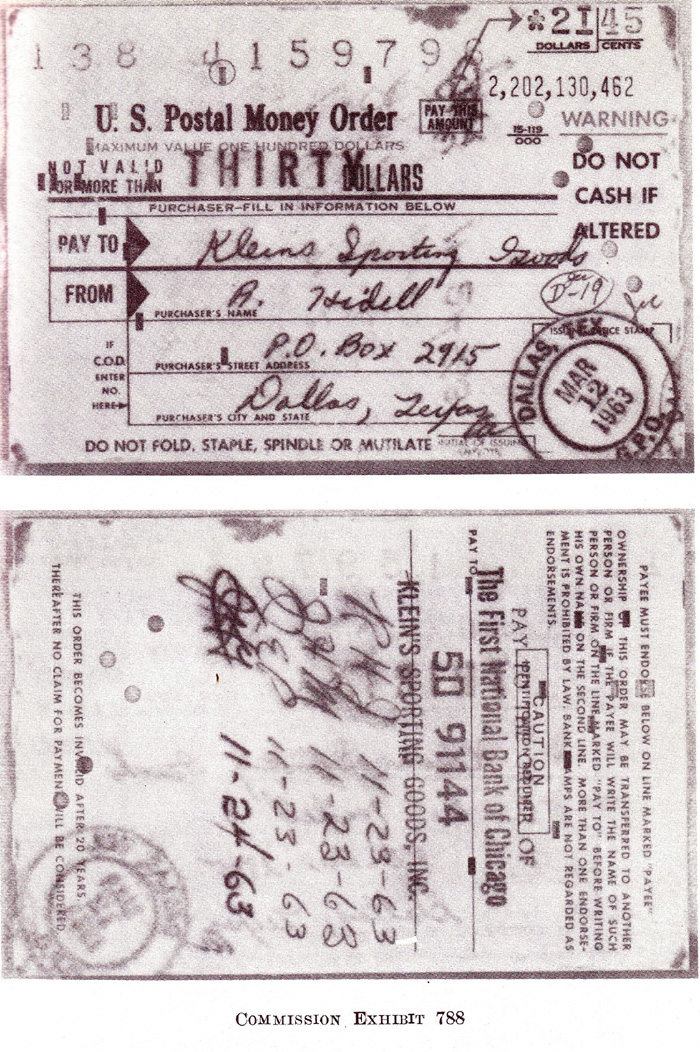
NOTE:
Serious researchers should be focusing attention on the inked postal
stamps that appear on the front of the money order (Dallas, TX, Mar 12,
1963), the inked endorsement stamp (Klein's) and the inked initials and
dates that appear on the back of this money order. An explanation is
needed as to how ink from the postal stamp and ink from the
initials/dates can "bleed" thru to the other side of the money order.
Postal money orders were made from card stock similar to
an index card or an IBM type punch card--between 90# and 110# paper.
This paper stock was crisp, firm, and ink "bleed-thru" to the reverse
side was virtually impossible. I don't understand why or how ink
"bleed-thru" occurred on CE 788. The original postal money order
disappeared long ago, and only FBI photographs of CE 788 remain. Who
authorized and/or caused the disappearance of the original money order
is unknown. Only black and white photographs remain. This ink
"bleed-thru" deserves a valid explanation.
DEPOSITING
THE MONEY ORDER.
US Postal money orders are normally deposited or cashed at a bank or
financial institution. They are date stamped, endorsed by the bank,
routed thru a Federal Reserve bank where they are endorsed and date
stamped a second time, and then sent to the postal money order center
in either Kansas City or Arlington, VA. where they are endorsed and
date stamped for a third time and placed in storage. But the $21.45
money order that was allegedly used to pay for "C2766" did not have a
single bank endorsement or date stamp by any bank or by a postal money
order center--this $21.45 money order was most certainly never
deposited to a bank or any financial institution.
Warren Commission attorney David Belin interviewed Klein's Vice
President William Waldman and questioned him about the money order.
Belin handed Waldman the uncashed, never deposited $21.45 money order
(Commission Exhibit 788) and asked him to read the words from the
Klein's rubber-stamped endorsement on the reverse side of the money
order. Then, with the unpaid money order in front of both men, neither
Belin
nor Waldman volunteered that this unpaid money order was never bank
endorsed,
never bank stamped, and never dated by any financial institution. In
other words, it should have been obvious to both men that this money
order had never been bank endorsed for deposit into a bank or cashed.
Waldman was asked to identify a $21.45 deposit as one of the entries
included in a total deposit of $13, 827.98, which he did (Waldman
exhibit 10). But there is nothing that identifies the source of this
$21.45 deposit (cash, check, money order, etc.). Now, let's look at the
date of the $13,827.98 deposit slip as shown in the Warren Volumes. It
is dated February 15, 1963--a month before Oswald allegedly ordered
the rifle from Klein's (March 12, 1963)... a month before!!
This was the ONLY deposit slip presented by the Commission, yet they
knowingly used this deposit slip, dated February 15, 1963, to help
prove that Oswald ordered a mail-order rifle from Klein's on March 12,
1963.
Robert Wilmouth, Vice President of the First National Bank of Chicago
was interviewed by the FBI on 11/23/63, but was never asked if the
unpaid $21.45 postal money order was deposited to his bank. Wilmouth
told the
FBI that a postal money order, after deposit to his bank, would have
been sent to the Federal Reserve Bank and then sent to the US postal
processing center in Kansas City. He told the FBI that the Federal
Reserve Bank would be able to identify the money order by number.
It would have been easy for the FBI to ask the Federal Reserve Bank to
identify the $21.45 postal money order by the number that appeared on
the FNB of Chicago deposit, but they never asked and for a very
good reason. The unpaid postal money order (shown above) was never
endorsed by the FNB of Chicago, never routed to the Federal Reserve
Bank and never endorsed by the Federal Reserve Bank. The Federal
Reserve Bank would not have a copy of this or any unpaid money order.
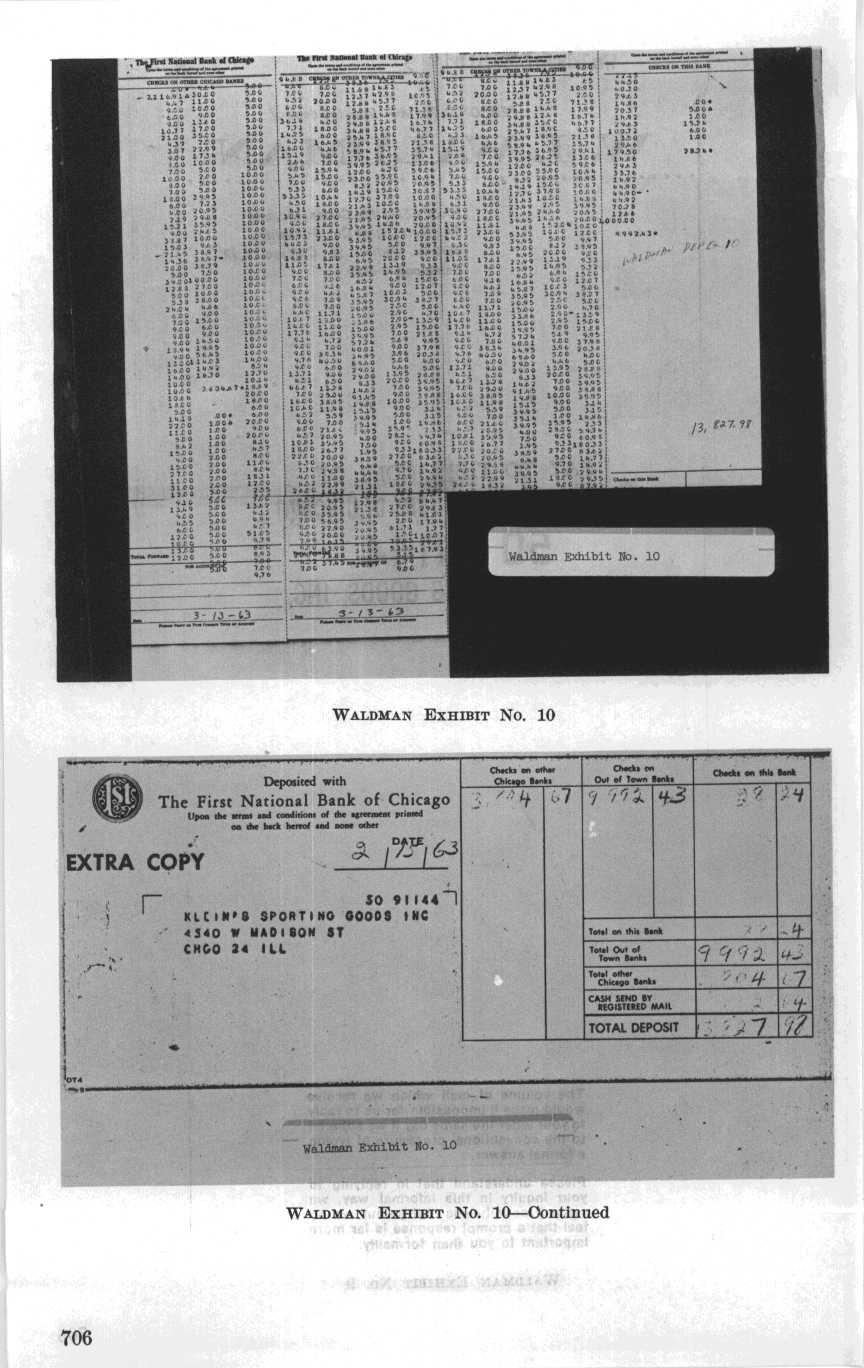
From
November 23 thru November 29, while television stations, radio, and
newspapers continued to report to the nation that a $12.78 mail order
rifle was used to assassinate President Kennedy, the FBI's attention
was focused on the 40" Mannlicher Carcano (C2766) and on the Klein's
microfilm. They ignored Louis Feldsott and his company records that
showed only one rifle with serial number C2766 was sold to Klein's--on
June 18, 1962. They quickly gathered all original records
related to C2766, including those from Harborside Terminal (a bonded
warehouse where Crescent stored the imported Italian rifles), Fred Rupp
(licensed gun dealer who reconditioned the Italian rifles), Lifschutz
Freight (transported rifles from Rupp to Klein's) and Klein's (retail
merchant). Each of these companies were required, by federal law, to
keep and maintain the serial number of each and every firearm received
and delivered. Each and every firearm imported into the US could then
be traced by serial number from its origin (Italy), importation into
the United States, refurbishing, sale to a retail establishment, and
the final sale to a retail customer. Accurate record keeping was
mandatory in the gun trade and strictly adhered to. But after the FBI
confiscated original records from Harborside, Rupp, Lifschutz,
and Klein's, they altered those records, photographed the altered
records, and then destroyed the original records. Only photographs
were given to the Warren Commission and only photographs remain at the
National Archives.
NOTE: Louis Feldsott's original records also disappeared and he was never questioned by the Warren Commission.
A $21.45 MAIL ORDER RIFLE. It appears that during the week of
November 23-29 the FBI was able to collect and alter enough documents
to convince the public that LHO purchased a $21.45 mail order rifle
from Klein's in March, 1963. The $12.78 mail order rifle, as reported
by the media, quickly faded into history as did information concerning
the rifle that Feldsott sold to Klein's on June 18, 1962. On November
29 (one week after the assassination) the Atlanta Journal reported from
a UPI dispatch that Oswald purchased an Italian rifle with scope from
Klein's Sporting Goods in Chicago in March, 1963 for $19.95 ($21.45
including postage). Photographs of altered documents were given
to the WC, which allowed the Commission to piece together the
importation, reconditioning, transportation and sale of "C2766" from
Harborside to Klein's to Oswald/Hidell in March, 1963.
From PHOTOGRAPHS, PAPER COPIES, an uncashed/never deposited money
order, and a deposit slip dated one month before the rifle was allegedly
ordered from Klein's, the FBI and Warren Commission concluded that
Oswald had purchased the rifle found on the 6th floor of the TSBD by
Dallas Police. They concluded that Oswald had clipped a coupon from the
February, 1963 issue of the American Rifleman magazine, wrote the name
"A. Hidell" on the coupon, listed his address as PO Box 2915, Dallas,
Texas and enclosed a postal money order in the amount of $21.45 for
payment.
NOTE: Without original records it is impossible for anyone to accurately trace "C2766" from the time it arrived in the United States to the time it was delivered to Klein's.
MANY UNANSWERED QUESTIONS. Neither the FBI nor Warren
Commission explained why Oswald ordered a 36" rifle, which Klein's had
in stock, but received a 40" rifle, which Klein's did not have in
stock.
They never explained why the rifle was sold without a sling, yet the
rifle found on the 6th floor of the TSBD had a long leather sling. They
never explained how Lee HARVEY Oswald was able to pick
up a package from the post office that was addressed to "A. Hidell."
According to postal regulations a letter or parcel addressed to anyone
other than the box hold would be stamped "addressee unknown" and
"returned to sender." They never explained why or how Oswald was able
to pick up a package that contained a firearm from the post office
without filling out postal form 2162, required
to be filled out by both the shipper and the receiver of a firearm.
They never asked Klein's nor the post office for a copy of this form, which
was required to be kept by the post office for 4 years.
They never explained where or how Oswald acquired an ammunition
clip or
ammunition for the rifle. The FBI never explained what happened to
the
Klein's microfilm. The FBI never explained what happened to the
original
records they confiscated from Crescent, Harborside, Rupp, and
Lifschutz. The FBI never explained what happened to the rifle (C2766)
sold
by Crescent to Klein's on June 18, 1962. Could this rifle (C2766),
shipped to an individual whose name was known only to the FBI, have
been the rifle found by the Dallas Police on the 6th floor of the TSBD.
SUMMARY OF C2766. Some 8-9 hours after President Kennedy was shot in Dallas, Crescent Firearms owner/President Louis Feldsott gave his company's original records relating to the importing and sale of C2766 to the FBI. According to company records Crescent Firearms sold C2766 to Klein's Sporting Goods on June 18, 1962. Klein's then re-sold this rifle (C2766) to an individual who's identity appeared on Klein's original microfilm records. On 11/23/63 three FBI agents examined Klein's original microfilm records and most likely knew the identity of the person who purchased C2766. But that person was not Oswald/Hidell. The identity of this person remains unknown. The FBI agents took the original Klein's microfilm, which was soon hand delivered to FBI headquarters in Washington DC. On March 27, 1964 the FBI advised the Warren Commission "the original records from which the film was made have been destroyed."
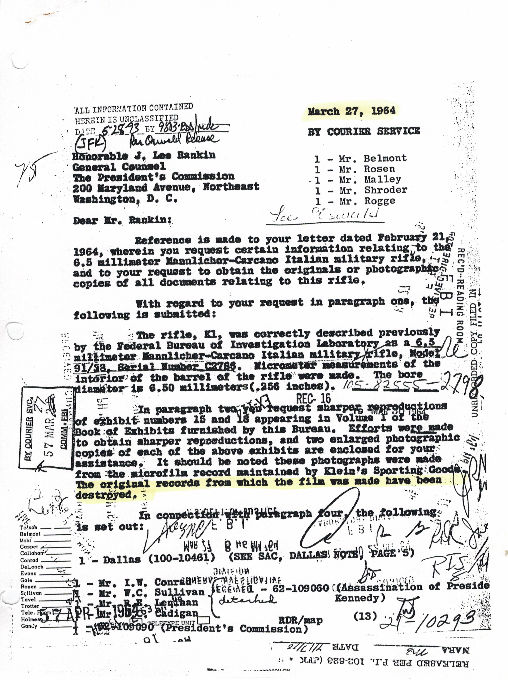
Who, in the US government, had the authority to destroy the business
records of a private company? For what legitimate reason would these
records be destroyed? By destroying the Klein's original microfilm it
was now impossible for anyone to determine if documents on the original
microfilm had been removed, altered, replaced, or fabricated. The FBI
gave the Warren Commission "photographs" of documents relating to
Oswald's alleged purchase of the rifle. The W.C. never saw or was
allowed to examine the original Klein's original microfilm.
The following document (below, left) is a synopsis of information provided by Louis Feldsott (Crescent Firearms) to the Warren Commission. The WC knew that Feldsott gave the original sales order, number 3178, to the FBI on the evening of 11/22/63. This original sales order shows that Crescent Firearms sold C2766 to Klein's on June 18, 1962. And Klein's microfilm records showed the name and address of the person or persons who purchased C2766 from Kleins. But all of Feldsott's (Crescent Firearms) original records disappeared while in FBI custody. And all of Klein's original microfilm records disappeared while in FBI custody.
The
FBI and Warren Commission ignored Louis Feldsott, ignored the original
Crescent Firearms sales order #3178, ignored Feldsott's affidavit
(below), and never provided any information as to the identity of the
person or persons who purchased the rifle (C2766) that was sold to
Klein's on June 18, 1962. Someone purchased C2766 from Klein's, but
this person was not Oswald/Hidell.
The
FBI needed needed to provide the Warren Commission with documents to
show that C2766 was sold by Crescent Firearms to Klein's in early 1963,
and was then re-sold to Oswald/Hidell. A Crescent Firearms invoice was
fabricated (below) to show that 100 rifles (including C2766) were sold
to Klein's on February 7, 1963. Note that #3178 (Crescent's
original sales order of June 18, 1963) appears on the fabricated
Crescent Firearms invoice. A Lifschultz Fast Freight shipping
document (below) was then fabricated to show that C2766 was
delivered to Klein's on February 21, 1963. Finally, a Klein's
invoice was created in order to show that C2766 was sold to
Oswald/Hidell on March 20, 1963.
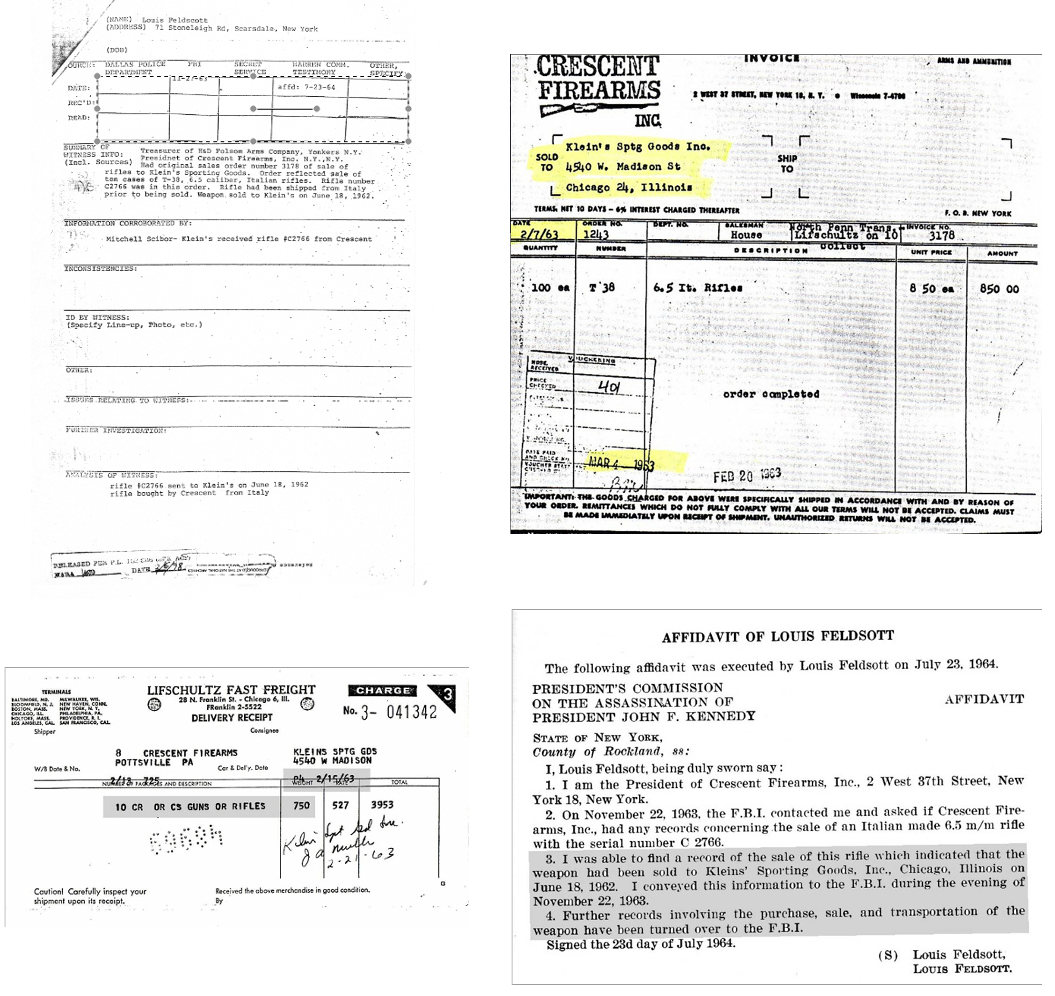
The
WC knew, from information provided by Louis Feldsott, that C2766 was
sold to Klein's on June 18, 1962. The Warren Commission also knew that
not a single document relating to C2766, provided by the FBI, was
original--all documents were either paper copies or photographs. This
"evidence" consisted of nothing more than paper copies and photographs
of altered and fabricated records. The Commission's willingness to
accept COPIES AND PHOTOGRAPHS OF DOCUMENTS, instead of insisting on
original documents, shows their collusion with the FBI in a deliberate
attempt to try and prove that Oswald purchased C2766 from
Klein's. The deliberate mis-handling and mis-interpreting of
these fabricated documents was obvious when WC Attorney David Belin
questioned Klein's Vice President William Waldman. Belin, again and
again, blatantly mis-lead and limited his questioning of Waldman in
order to show that C2766 was sold to Oswald/Hidell.
The complete details of the FBI's handling, manipulation and
fabrication of evidence, and the Warren Commission's handling and/or
suppressing witness testimony, are far too numerous to include in this
brief summary. But documentation and witness testimony published by the
Warren Commission clearly shows there is not a single, conclusive
piece of ORIGINAL evidence that proves Oswald ordered, purchased, or
received a rifle.
Dallas Police Chief Jesse Curry was correct when he said, "We don't
have any proof that Oswald fired the rifle. No one has been able to put
him in that building with a gun in his hand."
LIFE MAGAZINE PHOTOS. If Oswald never ordered the rifle, never
received
the rifle, and never held the rifle in his hands, then he could not
have held the rifle that appears in the backyard photographs. And if he
never held the rifle, then the backyard photos are fake. On the evening
of the assassination Robert and Patricia Hester, who worked for
National Photo Labs, saw several backyard photos in the hands of an FBI
agent, one day before they were "officially" found by Dallas Police
detectives in Ruth Paine's garage. That same evening one of the
backyard photographs was seen by Michael Paine and Washington
Evening
Star reporter Jeremiah O'Leary at Dallas Police headquarters. But
how
did the FBI and Dallas Police get their hands on the backyard photos a
day before they were found in Ruth Paine's garage? And if (HARVEY)
Oswald never ordered or received a rifle, then how and why were these
photos created?
The main reason to create the backyard photos was to link the rifle to
Oswald because, as we have seen, there is no proof whatsoever that he
ever ordered or received a rifle from Klein's Sporting Goods. But as
soon as the backyard photo appeared on the cover of Life Magazine,
Oswald was forever linked with the rifle. Whoever was responsible for
creating these photos had prior knowledge of the assassination.
How
did Life Magazine acquire the backyard photo? According to an
extensive FBI investigation, Life acquired the photo from an unknown
Dallas Police officer. And who was this unknown police officer?
Probably Roscoe White, who worked in the Dallas Police identification
bureau and was hired only weeks prior to the assassination by Captain
W.R. Westbrook. These photos show that it was Roscoe holding the
rifle, as evidenced by the large protrusion near his right wrist and
his large rectangular jaw.
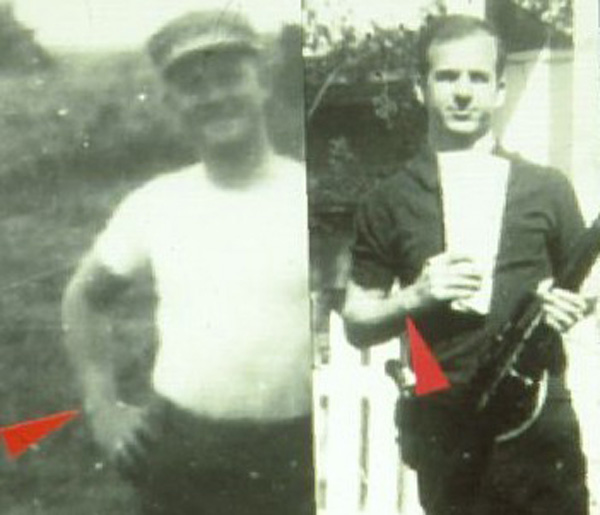 |
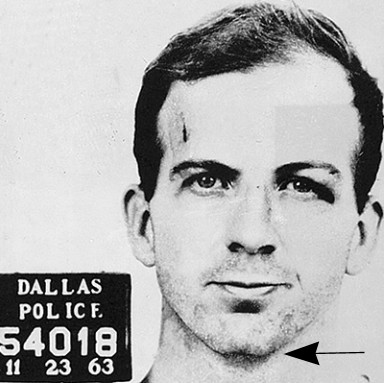 |
| Dallas Policeman Roscoe White is on the
left, and the alleged Lee Harvey Oswald is on the right. |
Harvey Oswald's DPD Mugshot. Notice
the difference in the chin compared to the photo at left. |
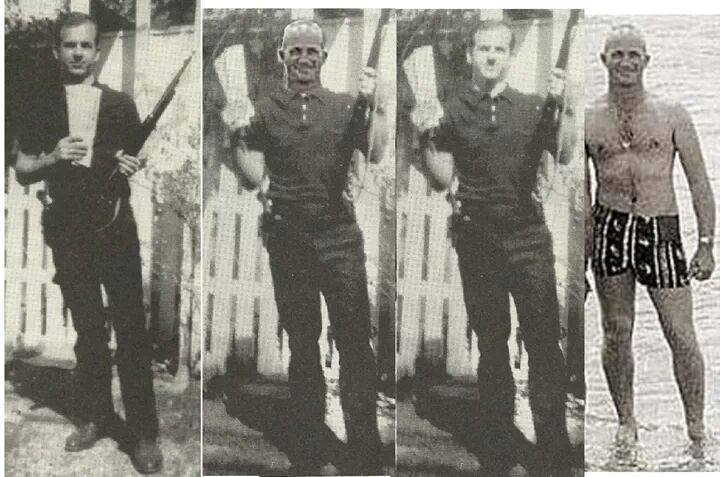
And it was Roscoe who could easily have added a backyard photo or film negatives to the evidence collected by the Dallas Police on the afternoon of November 22. And Roscoe may have been the unknown police officer who gave the photo to Life Magazine. After Roscoe's death, his wife found another backyard photo among his possessions. And in 1991 the Dallas Police found additional backyard photos in their files. These photos are another "smoking gun" and were created for the purpose of placing a rifle in Oswald's hands. They are further proof that Oswald was being set up as the "patsy" prior to the assassination.
Finally, what about the Imperial Reflex camera that was allegedly used by Marina to take the backyard photos? It was not found among Oswald's possessions at his rooming house, nor was it found at Ruth Paine's house, nor was it identified by Marina as belonging to Oswald when she was first shown the camera. In fact, Marina described a very different camera that she said was used by her to take the backyard photos. The Imperial Reflex camera first appeared 3 months after the assassination-on February 14, 1964 when Robert Oswald gave it to the FBI. And where did Robert get the camera? From Ruth Paine, who somehow was able to provide many items of evidence used to frame/incriminate Oswald in the months following the assassination, long after the police had thoroughly searched her home and garage.
![]()
